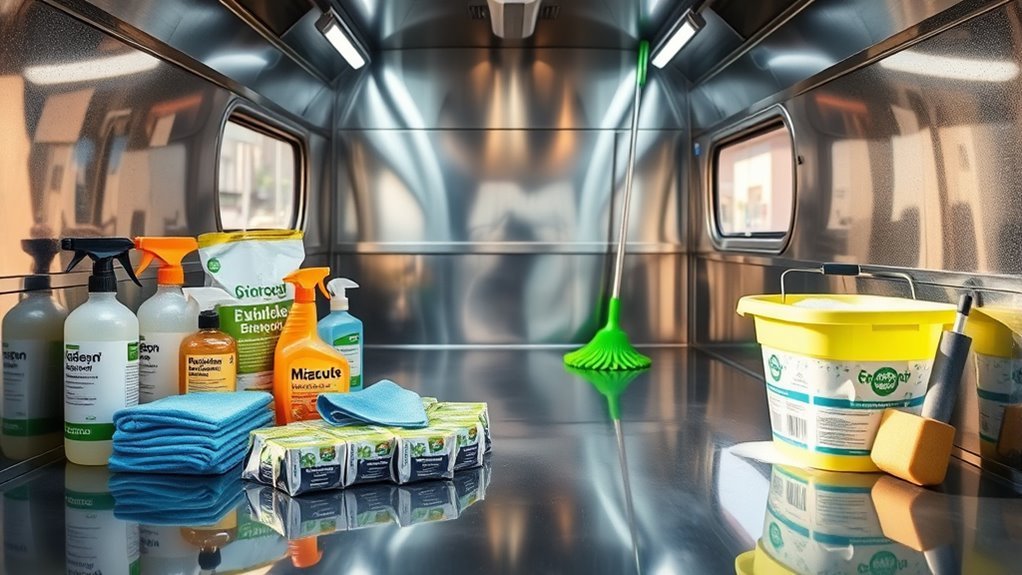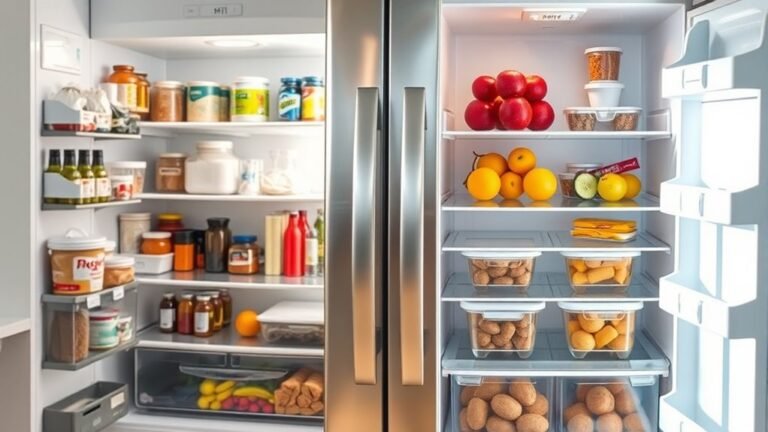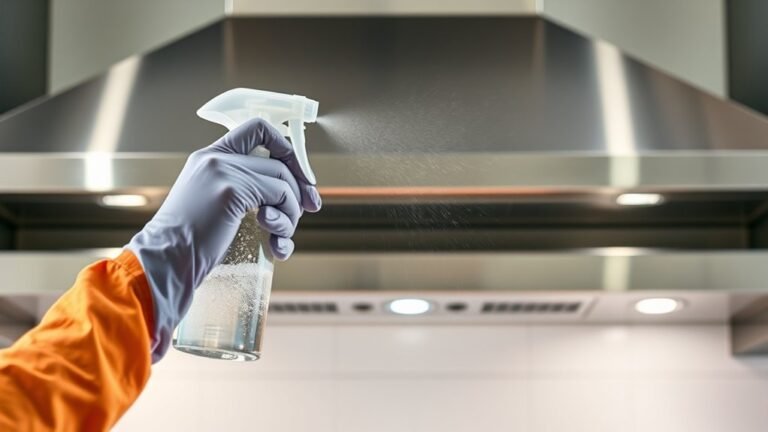Cleaning Tips for Food Trucks and Mobile Kitchens
You’ll want compact scrub brushes, multi-surface sprays, and quick-dry microfiber cloths to clean tight spaces efficiently. Keep your food prep areas wiped down daily, sweep floors, and empty trash regularly to stay on top of hygiene. Use disinfectants safe for food surfaces and keep waste sorted in labeled bins. Prevent cross-contamination with color-coded tools, and clean equipment after each use. Mastering these basics will help you manage your mobile kitchen’s cleanliness and safety with ease.
Essential Cleaning Supplies for Mobile Kitchens

To keep your food truck running smoothly, you’ll need a reliable set of cleaning supplies tailored for mobile kitchens. When you’re on the road, freedom means being prepared without carrying extra weight. Essential cleaning tools like compact scrub brushes, multi-surface sprays, and quick-dry microfiber cloths save you time and space. Mobile kitchen supplies should include a durable, portable hand sanitizer and grease-cutting degreasers that work efficiently in tight spots. Don’t forget a sturdy, easy-to-empty trash bin to keep waste under control. Choosing versatile, travel-friendly cleaning products helps you maintain hygiene effortlessly, so you can focus on serving your customers and hitting the road. With these essentials, your mobile kitchen stays spotless without tying you down, giving you the freedom to keep moving forward.
Daily Cleaning Checklist for Food Trucks
A daily cleaning checklist is key to keeping your food truck safe and efficient. Staying on top of cleaning frequency lets you enjoy the freedom of smooth operations without unexpected shutdowns. Good checklist organization saves time, so you never miss an essential task.
A daily cleaning checklist ensures your food truck runs smoothly and stays compliant without missing crucial tasks.
Here’s a simple daily checklist to keep your mobile kitchen in top shape:
- Clean and wipe down all food prep surfaces to prevent buildup.
- Sweep and mop the floors to maintain hygiene and safety.
- Empty trash bins and sanitize them to avoid odors and pests.
Proper Sanitization Techniques for Food Contact Surfaces

You’ll want to choose effective cleaning agents that are safe for food contact surfaces to guarantee proper sanitization. After applying these agents, make sure surfaces dry completely to prevent bacterial growth. Using the right methods keeps your food truck safe and your customers healthy.
Effective Cleaning Agents
Sanitizing your food contact surfaces is essential for preventing contamination and ensuring food safety in your truck. Choosing effective cleaning agents makes this task easier and eco friendly cleaners help you protect the environment while maintaining high disinfectant effectiveness. Here’s what you should keep in mind:
- Opt for eco friendly cleaners that are proven to kill bacteria without harsh chemicals, keeping your space safe and fresh.
- Use disinfectants specifically designed for food contact surfaces to guarantee thorough sanitization without leaving harmful residues.
- Always follow manufacturer instructions to maximize disinfectant effectiveness, ensuring your surfaces are truly clean and safe.
Surface Drying Methods
How should you dry food contact surfaces to guarantee they stay safe after cleaning? Choosing the right surface drying techniques is key to preventing contamination and keeping your food truck running smoothly. Avoid air drying since it can leave surfaces wet longer, inviting bacteria growth. Instead, opt for effective drying materials like clean, lint-free towels or disposable paper towels that quickly absorb moisture without leaving residues. Microfiber cloths are also a great choice—they dry surfaces efficiently and are reusable after proper laundering. Remember, drying isn’t just about removing water; it’s about maintaining a hygienic environment that protects both you and your customers. By mastering these surface drying techniques, you make certain your mobile kitchen stays fresh, safe, and ready to serve freedom-loving foodies wherever you roam.
Managing Waste and Recycling on the Go
You’ll want to set up clear bins for efficient waste segregation to keep things tidy and eco-friendly. Portable recycling solutions make it easier to manage materials without taking up too much space. Plus, minimizing food waste not only helps the environment but also cuts down on your disposal costs.
Efficient Waste Segregation
Although space is limited in a food truck, efficient waste segregation is crucial for keeping your operation clean and eco-friendly. You can enjoy the freedom of a clutter-free workspace while doing your part for the environment. Here’s how to master waste sorting and composting practices on the go:
- Designate separate bins for recyclables, compostables, and landfill waste to make sorting quick and intuitive.
- Use clear labels or color codes so everyone on your team knows exactly where to toss items.
- Regularly empty compost bins to avoid odors and pest issues, and guarantee food scraps go to a proper composting facility.
Portable Recycling Solutions
Keeping waste sorted is just the start; managing it efficiently while on the move can be a challenge in a compact food truck. You’ll want to invest in portable recycling bins that fit snugly into your limited space, making it easy to separate plastics, paper, and metals as you serve. These bins keep your truck organized and help you stay eco-friendly without slowing you down. For organic waste, consider on site composting solutions—compact composters designed for small spaces let you turn scraps into nutrient-rich material right where you work. Embracing these portable recycling solutions not only reduces your environmental footprint but also gives you the freedom to operate sustainably wherever your food truck takes you. It’s a smart way to keep waste manageable and your operation smooth.
Minimizing Food Waste
When you manage your food inventory wisely, minimizing food waste becomes much easier on the go. You can keep your mobile kitchen running smoothly while reducing your environmental impact. Here’s how to stay efficient and free:
- Plan portions carefully to match demand, avoiding excess leftovers.
- Partner for food donation programs to give surplus ingredients a second life.
- Implement composting initiatives for organic scraps, turning waste into resources.
Effective Grease and Oil Removal Methods
Since grease and oil buildup can quickly lead to slippery surfaces and unpleasant odors, you need reliable methods to tackle them effectively. Start by regularly cleaning your grease traps—they’re essential for capturing excess oils before they clog drains or create hazards. Use oil absorbents like pads or powders to soak up spills quickly, preventing slips and lingering smells. When scrubbing surfaces, choose degreasers designed for mobile kitchens to break down stubborn residues without damaging equipment. Always wipe down floors, counters, and cooking areas after each shift to keep grease from accumulating. Staying on top of these steps not only keeps your food truck safe and clean but also gives you the freedom to focus on what matters: serving great food without the stress of messy grease buildup.
Preventing Cross-Contamination in Tight Spaces

Managing grease and oil is just one part of maintaining a clean food truck—preventing cross-contamination is equally important, especially in the tight spaces you work in. You’ve got to be smart about food handling and space organization to keep your crew safe and your customers happy. Here’s how you can do it:
- Use color-coded cutting boards and utensils to separate raw and cooked foods, reducing the risk of mixing contaminants.
- Organize your workspace so that raw ingredients and ready-to-eat items have distinct, clearly marked areas.
- Clean and sanitize surfaces frequently, especially between tasks, to avoid transferring bacteria in cramped quarters.
Cleaning and Maintaining Cooking Equipment
Although it might seem time-consuming, cleaning and maintaining your cooking equipment regularly is essential to assure safety and keep everything running smoothly. You don’t want grime or bacteria slowing you down or risking your customers’ health. Stick to strict equipment disinfection routines after every use to kill harmful germs. Follow clear maintenance schedules to catch any wear or issues early, preventing costly breakdowns. Keeping your grills, fryers, and ovens spotless not only assures food safety but also extends their lifespan, saving you money in the long run. When you prioritize these tasks, you maintain freedom from unexpected repairs and downtime, letting you focus on serving great food and growing your business without hassle.
Best Practices for Floor and Drain Cleaning
Keeping your food truck’s floors and drains clean is one of the most important tasks to prevent slips, odors, and blockages. Proper floor maintenance and drain hygiene not only keep your workspace safe but also help you stay compliant with health standards while enjoying your freedom on the road. Here’s how you can stay on top of it:
Maintaining clean floors and drains is essential for safety, odor control, and health compliance in your food truck.
- Sweep and mop floors daily using a degreaser to remove food scraps and spills that cause slippery surfaces.
- Clean drains regularly by flushing them with hot water and a biodegradable enzyme cleaner to break down grease buildup.
- Inspect floors and drains weekly for cracks, standing water, or slow drainage to address issues before they escalate.
Scheduling Deep Cleaning for Long-Term Hygiene
Since regular cleaning tackles daily messes, scheduling deep cleaning sessions is crucial for maintaining your food truck’s long-term hygiene. You’ll want to set a clear hygiene maintenance schedule that fits your operation’s pace without tying you down. Typically, a deep cleaning frequency of once a month works well, but adjust it based on your menu complexity and customer volume. This thorough approach targets hidden grease, buildup, and bacteria that daily wipes miss, keeping your space safe and fresh. Sticking to a consistent schedule not only preserves equipment but also guarantees you’re always ready to roll without worrying about surprises. By planning deep cleanings ahead, you free yourself to focus on what you love—serving great food—while your truck stays spotless inside and out.
Frequently Asked Questions
How Often Should Food Truck Staff Wash Their Uniforms?
You should wash your uniforms regularly, wash them after every shift, and wash them whenever they get visibly dirty. Consistent uniform care is essential to maintain hygiene practices that protect both you and your customers. Staying fresh and clean lets you work freely without worries about contamination or odor. By prioritizing uniform care, you’re embracing freedom in your work environment, ensuring safety while expressing your commitment to a clean, professional appearance.
What Are the Best Eco-Friendly Cleaning Products for Mobile Kitchens?
When choosing cleaning products, you’ll want to go for biodegradable detergents and natural disinfectants. These options protect the environment while keeping your space spotless. Biodegradable detergents break down quickly, reducing pollution, and natural disinfectants like vinegar or tea tree oil work great without harsh chemicals. You’ll feel free knowing you’re cleaning responsibly, maintaining a healthy kitchen, and doing your part for the planet—all without sacrificing effectiveness or convenience.
How to Handle Cleaning During Unexpected Food Spills While Operating?
Spills often seem like chaos, but with smart spill management, they become just a quick pause in your flow. You’ve got to act fast—quick response is key to avoid slips or food contamination. Keep eco-friendly wipes and absorbent cloths handy, so you can clean up immediately without wasting time or harming the environment. Handling spills swiftly lets you stay free, focused, and confident while you keep serving great food on the go.
Can UV Light Be Used for Sanitizing Food Truck Surfaces?
You can definitely use UV sanitization to keep your food truck surfaces germ-free. It’s a great way to kill bacteria without harsh chemicals, giving you more freedom from traditional cleaning hassles. Just remember, UV light works best on smooth, non-porous surfaces, so its surface effectiveness depends on where you use it. Make sure to combine it with regular cleaning for the best results and keep your workspace safe and spotless.
What Are Signs That a Food Truck Needs Professional Deep Cleaning?
If your food truck looks like it’s wearing a cloak of visible grime, it’s shouting for professional deep cleaning. When cleaning frequency slips and dirt builds up in hard-to-reach spots, it’s time to call in the pros. You don’t want grime to clip your wings or turn away customers craving freedom from filth. Deep cleaning resets your space, keeping your kitchen shining and your business flying high.






